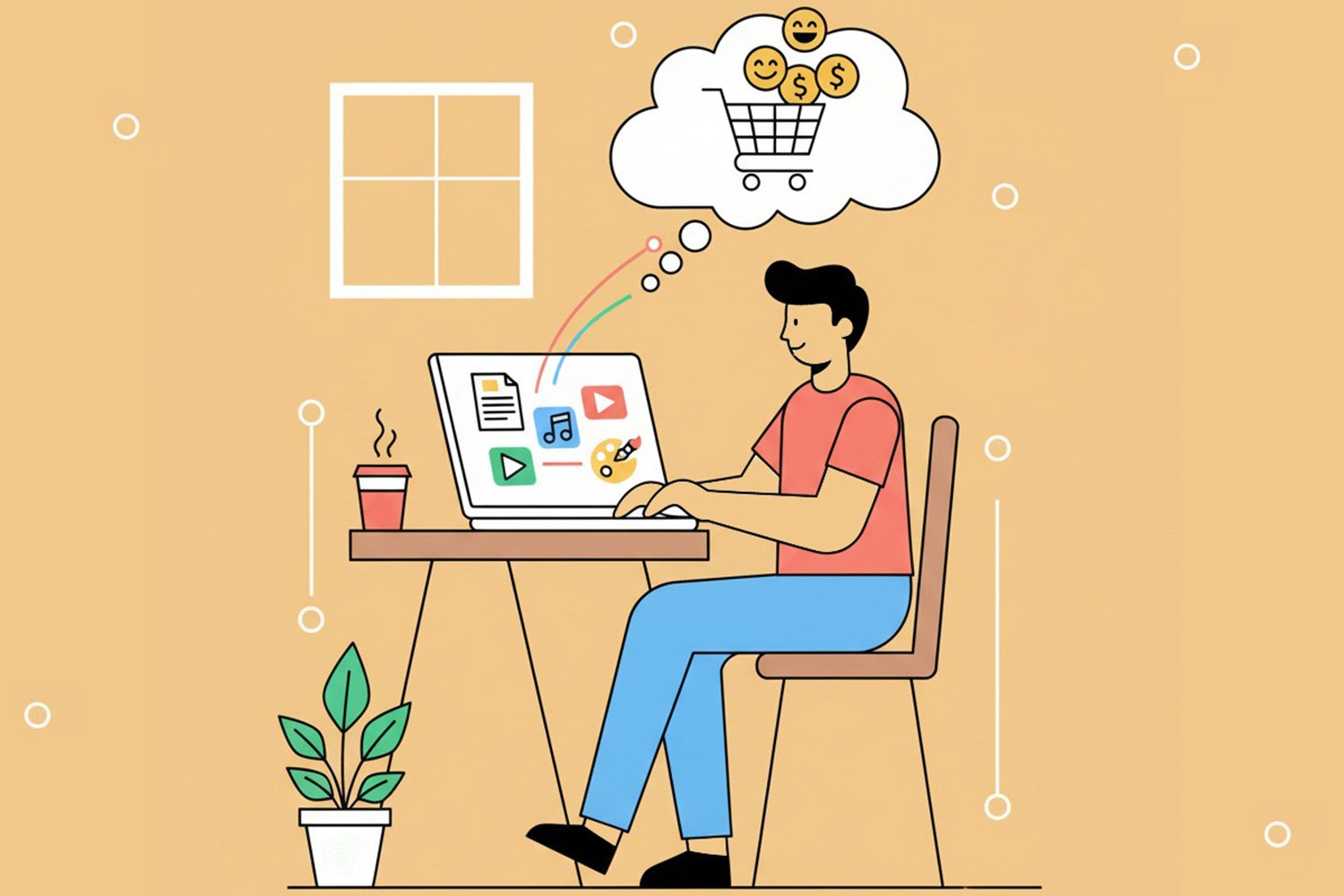Table of Contents
Everywhere you look, people are consuming digital products: streaming playlists, downloading ebooks, taking online courses, using templates, and grabbing stock images. Unlike physical goods, digital products don’t need warehouses, shipping labels, or supply chains. They’re made once, sold infinitely, and available instantly.
For entrepreneurs, freelancers, and creators, digital products have become one of the most practical ways to start and scale a business. They offer flexibility, low overhead, and the ability to turn knowledge or creativity into recurring income. Whether you’re a teacher, designer, musician, or someone with a valuable idea, digital products open the door to a global marketplace.
1. What Are Digital Products?
Digital products are items you can buy, sell, and use entirely online—no physical delivery required. Instead of being shipped in a box, they’re downloaded or accessed through a login.
They can take many forms:
- An ebook that teaches mindfulness
- A set of Photoshop brushes for designers
- A budget spreadsheet for freelancers
- A library of stock video clips for content creators
The core feature is that once created, you can distribute a digital product at virtually no additional cost. That makes digital goods highly scalable compared to traditional inventory-based businesses.
2. Why Sell Digital Products?
Digital products have surged in popularity because they align with the way people live and work today. Here’s why entrepreneurs keep turning to them:
Low overhead. You don’t need warehouses, packaging, or postage. Once your product is complete, selling it costs little more than hosting fees or a store platform subscription.
Global reach. A course recorded in one city can be accessed instantly across the world. Geography is no longer a barrier.
Scalability. Unlike consulting or services that trade time for money, content creators, marketers, teachers, and coaches, and others can sell digital products repeatedly without requiring additional effort.
Flexibility. From highly polished video courses to quick printables, you can tailor offerings to your skills, budget, and niche.
Consumer demand. More people than ever are learning online, managing their lives with digital tools, and decorating homes with printable art.
3. Popular Types of Digital Products
The digital marketplace is broad, but certain categories consistently thrive.
Ebooks and Guides
Self-publishing has exploded. Authors, coaches, and subject matter experts sell ebooks to share insights, teach skills, or entertain. They can be lengthy works, such as comprehensive guides or concise, focused PDFs.
Courses and Workshops
Video lessons, masterclasses, and cohort-based workshops let you monetize expertise. Platforms like Teachable or Thinkific make it easy to host and deliver.
Digital Art and Graphics
Designers and illustrators sell printable wall art, social media graphics, fonts, and icon packs. Marketplaces such as Creative Market and Etsy have thriving audiences.
Templates and Tools
From resume layouts to Notion dashboards, people are willing to pay for ready-made tools that save time. Productivity templates have surged in popularity with the rise of remote work trends.
Music and Audio
Musicians sell beats, sound effects, jingles, and background tracks. Podcasters and video editors often buy licensed audio to enhance their content.
Software and Apps
Developers package solutions as downloadable software, plugins, or mobile apps. Some are sold once, while others run on subscriptions.
Printables and Journals
Printable planners, affirmation cards, and kids’ activity sheets are popular low-barrier entries into the market.
Stock Footage and Video Elements
Video creators need B-roll, animations, and overlays. Selling clips to marketplaces can generate steady royalties.
4. How to Create a Digital Product
The best products start with solving a problem or fulfilling a desire. Here’s a practical roadmap:
1. Find an idea. Consider your skills, passions, and professional background. What do people ask you for advice on? What shortcuts have you created for yourself that others would pay for?
2. Validate demand. Use Google Trends, Reddit, or keyword research tools to see if people are searching for your topic. Forums and Facebook groups can be goldmines for real problems people want solved.
3. Choose a format. Some content is best as a visual PDF, others as an interactive template, and others as a full video series. Match the format to the problem.
4. Produce with tools.
- Design: Canva, Adobe Suite, Figma
- Audio: Audacity, Logic Pro, GarageBand
- Video: Screenflow, OBS, Premiere
- Documents: Notion, Google Docs, Microsoft Office
5. Polish and package. Good design matters. Even a simple product should be clear, user-friendly, and visually appealing.
5. Where and How to Sell Digital Products
Once you’ve created something valuable, the next step is getting it into buyers’ hands. You can sell through:
Marketplaces
- Etsy: Best for printables, art, and creative templates
- Gumroad: Simple storefronts for creators
- Creative Market: Graphic design and photography assets
Your own storefront
- Shopify: Full-featured online store with digital product apps
- WordPress + WooCommerce: Flexible and customizable
- Squarespace: Easy all-in-one solution
Hybrid platforms
- Amazon Kindle Direct Publishing: For ebooks
- Udemy and Skillshare: For video courses
- App stores: For mobile apps and games
Pricing strategies:
- One-time purchases (common for ebooks, templates)
- Subscription models (great for ongoing content or tools)
- Tiered pricing (basic vs. premium versions)
For delivery, most platforms handle automatic downloads or member logins. You can also integrate services like SendOwl or Payhip to securely manage files.
6. Marketing Digital Products
A great product won’t sell itself. Here’s how to bring it to the right audience:
Content marketing. Blog posts, YouTube videos, and podcasts establish authority and drive organic traffic.
Email lists. A newsletter builds trust and allows direct promotion. Free lead magnets, such as mini-guides, can help grow your list.
Social media. Instagram, Pinterest, and TikTok work exceptionally well for visual products. Twitter/X and LinkedIn can help with professional or B2B products.
Paid advertising. Facebook, Google, and TikTok ads can quickly scale reach when paired with a well-optimized funnel.
Affiliate programs. Recruit others to promote your product in exchange for commission.
Trust signals. Reviews, testimonials, and clear previews increase buyer confidence.
7. Common Challenges and How to Overcome Them
Selling digital products isn’t without hurdles.
Saturation. Many niches are crowded. The solution? Narrow your focus. Instead of “budget spreadsheets,” try “budget spreadsheets for new parents.”
Piracy. File sharing is a reality, but you can mitigate it with watermarks, license terms, or by offering community benefits that piracy can’t replicate.
Technical hurdles. Some creators fear the tech side. Fortunately, beginner-friendly platforms handle most of the heavy lifting. Start simple and upgrade as you grow.
Consistency. Many entrepreneurs launch one product and stop. Success usually comes from building a catalog and nurturing an audience over time.
8. Inspiring Examples
- The teacher who sells lesson plans. Educators have turned classroom materials into thriving side businesses on Etsy and Teachers Pay Teachers.
- The designer who sells templates. From Canva templates to resume layouts, designers create once and earn for years.
- The musician licensing beats. Independent producers sell instrumentals to creators, generating ongoing royalties.
- The coach with an online course. Coaches and consultants scale beyond one-on-one clients by turning knowledge into structured programs.
These examples prove that you don’t need a massive following or a huge team. What matters most is identifying a need, creating value, and delivering it in digital form.
Conclusion
Digital products are one of the most accessible business models today. They combine low startup costs with unlimited scale, offering creators a path to both freedom and impact.
If you’ve been waiting to get started, now is the time. Select one idea, validate the demand, and develop a straightforward product. Launch it, learn from your audience, and improve with each iteration. The digital marketplace is wide open, and your expertise, creativity, or unique solution could be the next product people are searching for.
Related Links
Shopify Blog: How to Sell Digital Products
Gumroad: Creator Stories and Guides
Etsy: Digital Downloads Marketplace






